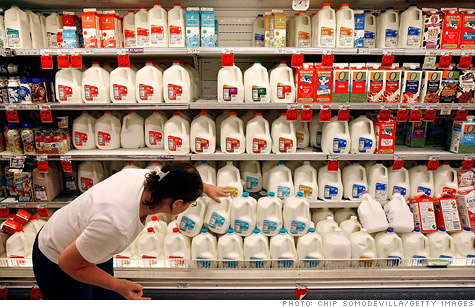Search News

Milk futures rose 36% in 2011, far steeper than the 9.8% rise in milk prices that U.S. consumers paid.
NEW YORK (CNNMoney) -- The commodity which enjoyed the biggest gain in price last year can be answered with a simple question: Got milk?
That's because milk, not gold, oil, or any of the more popular futures contracts, enjoyed about a 35.7% rise in price in 2011 to close at 18.77 cents per pound.
That compares to an 11.7% rise in the price of gold and a 10% rise in crude oil prices. It also blows away the more modest gains of the higher profile food futures, like pork bellies, corn and coffee.
But before you rush out to the nearest grocery store to buy every drop of milk in an effort to build your retirement nest egg, a clarification: Milk futures are not for the type of milk consumers bring home in gallon jugs. They're for a class of milk that is typically powdered or condensed and used in production of other products such as cheese. That class of milk makes up just more than half of the 195 billion pounds of milk produced in the United States annually.
The price of liquid milk bought by consumers has so far been spared these price shocks. Still, the Consumer Price Index shows a 9.8% rise in liquid milk prices over the 12 months ending in November.
One of the main factors driving the rise in milk futures on commodity markets is a rise in export demand.
Because of its perishable nature, liquid milk is not widely exported. But the Census Bureau reports that condensed or powered milk exports surged 26% in the first 10 months of 2011, the latest figures available, to $1.3 billion.
"We still use most of our production for domestic commercial needs, but the driver of the market is really the export market," said David Lehman, managing director of commodity research at CME.
Countries in Asia and South America had some of the biggest increases in U.S. milk imports.
But while the rising prices have been good news for dairy farmers and other producers, it hasn't been the windfall that outsiders might expect, said Jim Tillison, senior vice president of marketing and economics for the National Milk Producers Federation, a trade group.
"Feed costs are up as well so it's not a record breaking year, but it's better than the past couple of years," he said. ![]()
| Index | Last | Change | % Change |
|---|---|---|---|
| Dow | 32,627.97 | -234.33 | -0.71% |
| Nasdaq | 13,215.24 | 99.07 | 0.76% |
| S&P 500 | 3,913.10 | -2.36 | -0.06% |
| Treasuries | 1.73 | 0.00 | 0.12% |
| Company | Price | Change | % Change |
|---|---|---|---|
| Ford Motor Co | 8.29 | 0.05 | 0.61% |
| Advanced Micro Devic... | 54.59 | 0.70 | 1.30% |
| Cisco Systems Inc | 47.49 | -2.44 | -4.89% |
| General Electric Co | 13.00 | -0.16 | -1.22% |
| Kraft Heinz Co | 27.84 | -2.20 | -7.32% |
| Overnight Avg Rate | Latest | Change | Last Week |
|---|---|---|---|
| 30 yr fixed | 3.80% | 3.88% | |
| 15 yr fixed | 3.20% | 3.23% | |
| 5/1 ARM | 3.84% | 3.88% | |
| 30 yr refi | 3.82% | 3.93% | |
| 15 yr refi | 3.20% | 3.23% |
Today's featured rates: